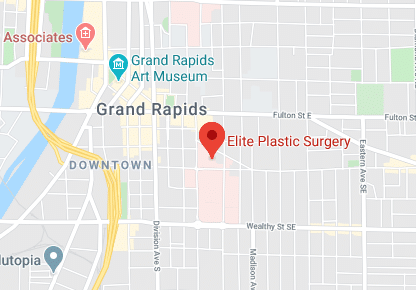Burns can be minor inconveniences, say a burn on your finger from touching a hot grill, or they can be life-threatening emergencies. Once the initial damage has been addressed, more severe burns will likely need plastic surgery to repair damaged areas of the skin.
Our highly skilled plastic surgeons at Elite Plastic Surgery can provide you with burn care and treatment! Dial (616) 459-1907 today to reach our Grand Rapids office.
What Are the Signs that a Burn is a Medical Emergency?
There are times when a person has suffered a burn that is a medical emergency:
- Burns that cover the hands, feet, face, groin, buttocks, a major joint or a large area of the body
- Deep burns, meaning a burn that affects all three layers of the skin
- Burns that cause the skin to look leathery
- Burns that appear charred or have patches of black, brown, or white
- Burns caused by chemicals or electricity
- Burns to the airway that is causing difficulty breathing
What If I Have Been Treating My Burn at Home, When Should I See a Doctor for Burn Treatment?
If you’ve had a burn but have been treating it at home, these are instances when you would now need to see a doctor:
- Signs of infection, such as oozing from the wound, increased pain, redness, and swelling
- A burn or blister that’s large or that doesn’t heal in two weeks
- Significant scarring
- New, unexplained symptoms
What are the Different Types of Burns?
Burns are categorized by type: first-degree, second-degree, and third-degree. These are classified in ascending order, with first-degree burns being the least severe and third-degree burns being the most severe.
First-degree burns
These are the least severe, only damaging the outer layer of the skin, the epidermis. As with a sunburn, the skin turns red and may feel warm and painful. There are no blisters or open wounds. First-degree burns can heal on their own without medical treatment.
Second-degree burns
This type of burn affects both the epidermis and the dermis, the skin’s second layer. The burned area turns pink or red, is very moist, and develops blisters. These may heal on their own if the burn is not too deep. However, if they are deeper, the skin is likely to reopen. Skin grafting may be necessary.
Third-degree burns
This burn reaches down to the fat layer, beneath the dermis. Burned areas may be black, brown, or white. The skin may look leathery. These burns may not be painful, as they can destroy the nerves in the skin. While very small third-degree burns may heal on their own, the process will take a very long time. Any third-degree burn larger than a fifty-cent piece must be grafted or it will not heal.
What are the Treatment Options for Severe Burns?
For severe burns, the patient may require breathing assistance and feeding assistance. If the burn completely encircles a limb, the scab may cut off blood circulation, requiring the scar, called an eschar, to be cut.
To repair the severe burn after the patient has stabilized, plastic surgery will likely be necessary. This will employ skin grafts and other methods. After skin grafts have been successful, other plastic surgery may be necessary to improve the appearance of the burn scars and to increase the flexibility of joints affected by scarring.
Skin grafts
A skin graft is a thin layer of skin taken from one area of a person’s body to cover another burned area of their skin. There are three kinds of skin grafts: sheet grafts, mesh grafts, and full-thickness grafts.
Sheet grafts
These are solid pieces of skin that are attached over the burn with staples or stitches. They are used to cover smaller burned areas, such as on the face and hands. Once the graft is attached, it will turn from white to bright pink in about five days. This pink color is a sign that blood supply is forming in the grafted skin.
Mesh grafts
Mesh Grafts are used to cover larger areas of the body. The donor skin has been cut with a special tool to allow it to be spread over a larger area. The mesh graft has a diamond pattern and is attached over the burn with staples.
Full-thickness grafts
Full-Thickness Grafts are used for reconstruction of small areas that are prone to contractures, such as the hands or chin. These grafts consist of the full thickness of the skin and they shrink the least compared to other grafts.
How Long Will it Take My Grafts to Heal After a Severe Burn?
When you have a skin graft, you’ll actually have two sites that need to heal: the burn site and the donor site. Skin grafts typically heal in about two weeks, as do donor sites.
How Do I Prepare for Reconstructive Surgery After a Burn?
Preparations for these surgeries are the same as with any surgery: stop taking blood-thinning medications, anti-inflammatory medications, and most supplements. Stop smoking for a month before, if possible, and after your surgery.
What is Involved with Post-Treatment Burn Care?
Caring for your treated burn will be important to avoid infection and maintain the repair.
- Moisturizing — This is important to decrease the chances of developing blisters or skin tears. It also decreases itching and makes movement easier. We’ll talk about the right lotions for your situation.
- Blisters — Your newly healed skin is fragile. Blisters can form on the scar quite easily. They should be pierced and drained as soon as you notice them. Use a sterile needle to make a small hole and drain the blister onto a piece of gauze. Apply antibiotic ointment.
- Skin tears — These occur when you bump into something, such as a countertop. Apply pressure for about 5 minutes until the bleeding stops. Wash the area and apply antibiotic ointment and a nonstick dressing.
- Ulcerations — These are breakdowns in the skin that occur across the bands of scar tissue around the shoulder, the front of the elbow, and the back of the knee. Movement can cause them. Try and keep the wound covered with a thin film of antibiotic ointment, especially when exercising.
Will my Burn Treatment Leave a Scar?
That depends on the severity and size of your scar. First- and second-degree burns rarely scar. They can result in a change of pigment on the skin that was burned. Third-degree burns will involve some scarring, but that’s where post-treatment plastic surgery with the expert team at Elite Plastic Surgery can make all the difference.
What Happens if a Burn is Left Untreated?
Minor burns can be treated at home and will usually heal within a couple of weeks. While they will likely heal if left untreated, they will probably heal quicker if treated. Treatments for first-degree burns would include soaking the burn in cool water, taking acetaminophen or ibuprofen, applying aloe vera gel, and using the antibiotic ointment.
Second- and third-degree burns carry risks of infection if not appropriately treated. Second-degree burns need to be managed to speed healing, deal with blisters, and avoid scarring. Third-degree burns always need treatment. This will involve skin grafts and possible additional plastic surgery. Without it, beyond the intense risk of infection, these burns will heal with severe scarring and contracture.
Tetanus is a possible complication with untreated burns of all levels. This is a bacterial infection that affects the nervous system.
What Our Patients Have to Say
“Very friendly and empathetic staff, professional and courteous, prompt & efficient yet not rushed. Various treatment options presented, not pushy to treat issue as to what doctor wants, more interested in treatment that patient feels best for the patient needs & wishes!” -D. J.
Click here to read more reviews.
Schedule Your Burn Care & Treatment Consultation In Grand Rapids, MI!
To schedule a consultation or to learn more about our Burn Care and Treatment options, contact us today at (616) 459-1907 or our toll-free number: (866) 331-0612. Our practice serves Grand Rapids, MI, and the surrounding areas.



